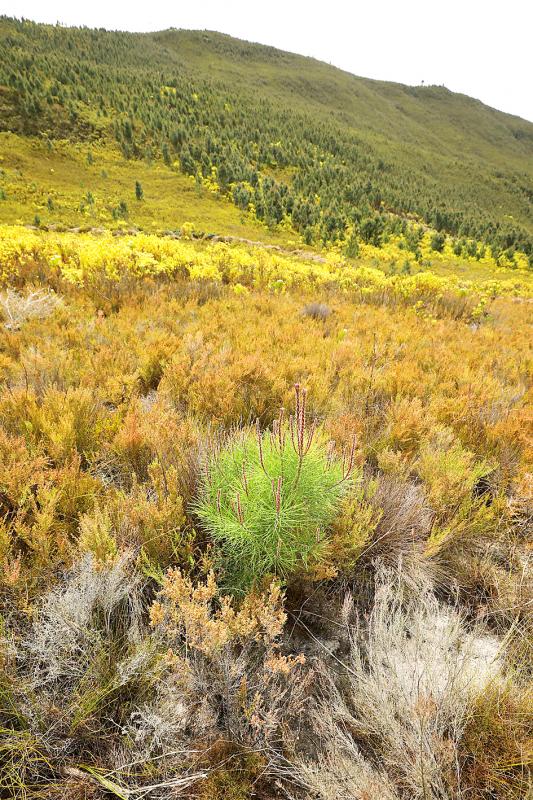In South Africa’s Franschhoek mountains a helicopter drops off abseilers to cut down invasive pine trees that are choking off water supplies to millions of Cape Town residents already facing climate change-induced shortages.
The crews are there to help to remove 54,000 hectares of alien trees by 2025, in the process reclaiming an estimated 55 billion liters of water lost each year — two months of water supply for Cape Town.
Using hand saws to cut saplings while dangling over craggy cliffs, the team is targeting infestations of alien tree species, mainly pine, but also Australian acacia and eucalyptus, that carpet swathes of mountainside in dark green foliage.

Photo: Reuters
“We can’t eradicate the pines, but we’ve got to manage and control them because the scale is too big. It’s a massive problem,” said Louise Stafford, South Africa’s program director at The Nature Conservancy, a non-governmental organization leading the process.
The control of the pines was fast-tracked in 2018, when Cape Town narrowly avoided having its taps run dry during a drought dubbed “Day Zero.”
Pine trees, first introduced from Europe during the 17th century, are now the backbone of South Africa’s commercial forestry industry. However, their small seeds are easily dispersed by the wind and, with no natural enemies, they can spread rapidly from plantations to protected nature reserves, scientists said.
The alien trees also threaten native animals and plants in the Cape Floral Kingdom, where 70 percent of the plants, like the famous fynbos range of plants that are found nowhere else on the planet.
A single pine tree consumes at least 20 percent more water than the fynbos.
The animals under threat include the rough moss frog, which was discovered in 2008, about 100km east of Cape Town on the slopes of Caledon’s Klein Swartberg mountains, which are drained by three vital rivers.
“Out of the five sites we are monitoring, three no longer have any [rough moss] frogs. If we do not remove this carpet of pine trees there is no doubt the frogs will become extinct,” said John Measey, a zoologist at Stellenbosch University’s Centre for Invasion Biology.
Removing dense pine thickets is a huge task, but necessary.
“We are eating this elephant piece by piece,” Klein Swartberg Nature Conservancy chairman Lambert Fick said, as workers prepared ahead of a controlled fire to clear the area — a practice that some conservationists regard as risky.
Introducing moths, weevils or mites is also being considered to combat the trees, said Andrew Turner, a restoration ecologist at government agency CapeNature.
“It is not a silver bullet ... [they] cannot get rid of existing infestations, but rather stop it spreading further,” he said.

Asian perspectives of the US have shifted from a country once perceived as a force of “moral legitimacy” to something akin to “a landlord seeking rent,” Singaporean Minister for Defence Ng Eng Hen (黃永宏) said on the sidelines of an international security meeting. Ng said in a round-table discussion at the Munich Security Conference in Germany that assumptions undertaken in the years after the end of World War II have fundamentally changed. One example is that from the time of former US president John F. Kennedy’s inaugural address more than 60 years ago, the image of the US was of a country

BLIND COST CUTTING: A DOGE push to lay off 2,000 energy department workers resulted in hundreds of staff at a nuclear security agency being fired — then ‘unfired’ US President Donald Trump’s administration has halted the firings of hundreds of federal employees who were tasked with working on the nation’s nuclear weapons programs, in an about-face that has left workers confused and experts cautioning that the Department of Government Efficiency’s (DOGE’s) blind cost cutting would put communities at risk. Three US officials who spoke to The Associated Press said up to 350 employees at the National Nuclear Security Administration (NNSA) were abruptly laid off late on Thursday, with some losing access to e-mail before they’d learned they were fired, only to try to enter their offices on Friday morning

STEADFAST DART: The six-week exercise, which involves about 10,000 troops from nine nations, focuses on rapid deployment scenarios and multidomain operations NATO is testing its ability to rapidly deploy across eastern Europe — without direct US assistance — as Washington shifts its approach toward European defense and the war in Ukraine. The six-week Steadfast Dart 2025 exercises across Bulgaria, Romania and Greece are taking place as Russia’s invasion of Ukraine approaches the three-year mark. They involve about 10,000 troops from nine nations and represent the largest NATO operation planned this year. The US absence from the exercises comes as European nations scramble to build greater military self-sufficiency over their concerns about the commitment of US President Donald Trump’s administration to common defense and

Cook Islands officials yesterday said they had discussed seabed minerals research with China as the small Pacific island mulls deep-sea mining of its waters. The self-governing country of 17,000 people — a former colony of close partner New Zealand — has licensed three companies to explore the seabed for nodules rich in metals such as nickel and cobalt, which are used in electric vehicle (EV) batteries. Despite issuing the five-year exploration licenses in 2022, the Cook Islands government said it would not decide whether to harvest the potato-sized nodules until it has assessed environmental and other impacts. Cook Islands Prime Minister Mark Brown